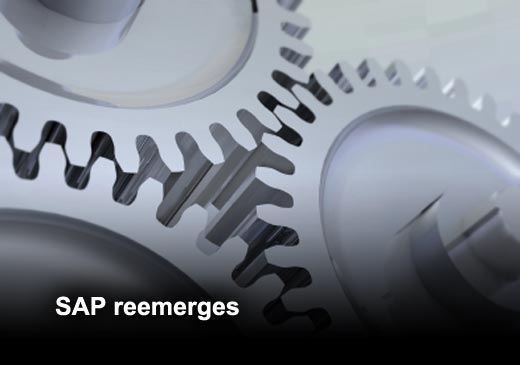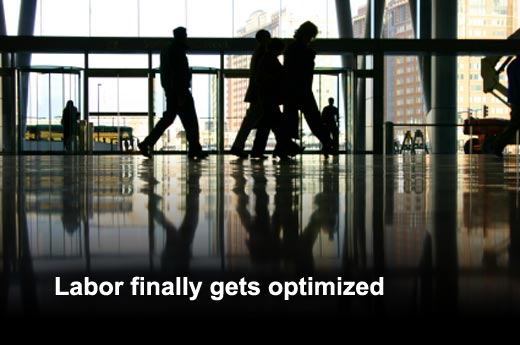Tight capital budgets, the European banking crisis, and the unending U.S. budget debate make predictability – and taking on less risk – even stronger themes for 2012. In the technology world, mobility, the cloud, and big data (very large data sets and their related challenges) are a few of the trends driving Nucleus Research’s 2012 predictions.
Click through for the top 10 trends for 2012, as identified by Nucleus Research.
Spurred on by the adoption of Facebook, many enterprise software vendors have clamored to add “social” capabilities to their applications. Salesforce.com has Chatter, Microsoft and others have social connectors, and new vendors such as HubSpot and Yammer have emerged to capitalize on the social phenomenon. Nucleus’s analysis has found integrating capabilities like Chatter can drive an average productivity increase of 20 percent. However, for every organization that has successfully adopted social capabilities, there are two that struggle to make it work: either users don’t adopt or they don’t use it for any redeeming business purpose.
The biggest concern about the social enterprise is that it brings the productivity leaching characteristics of Facebook into the legitimate work technology environment, and that employees will use it for socializing and sharing Farmville tips, not for more effective work. This is a legitimate concern.
The most successful firms in 2012 and beyond will surpass social enterprises to become productive enterprises. They will use the acceptance of “social” tools to drive collaboration, work sharing, and more capable workers. They will take advantage of mobile device access to collaborative networks to spur employees to work during down time, day time, and night time. They will align, coax, and prod social tools to support clear business purposes and direct workers on how to use them to get ahead and stay employed. They will leverage social technology to build the productive enterprise.
First, the cloud made development faster. In fact, last year Nucleus found Force.com development was 4.9 times faster than traditional development. Then, the cloud made development more iterative. When changes can be made on the fly, companies can deploy once and then adapt an application as business needs change or become clearer.
Moving forward, the cloud will also make development even more virtual: companies don’t care where the developer is as long as good code is delivered on time. Crowdsourcing efforts like CloudSpokes and the integration of social networking tools into the development environment (such as, let’s all vote on who built the most elegant solution) will provide opportunities for talented developers no matter where they live and challenge traditional systems integrators that are used to hiding behind billable hours and big bang projects.
OK, this is one prediction Nucleus may have missed in 2010 – but they also have to admit that they’ve seen a lot of big changes in SAP and in the business environment in the past year. SAP revenues have gone up and the company has introduced innovations in areas like mobile device access. They’ve started to see real traction with Business ByDesign. This is partly because customers that have growth aspirations are also risk averse given the economy: they want to put in business-class financial controls earlier rather than later. This is also because cloud delivery makes Business ByDesign less onerous to support than traditional ERP deployments. Some wondered if a dual-CEO role would work at the behemoth, but their take is that Leo’s departure was the best thing to happen to SAP in a while (in hindsight, HP probably agrees). SAP still needs to focus on maximizing the value its customers achieve, but it has created a lot of opportunities for innovation in its ecosystem. What a difference 19 months makes!
As acquisitions continue to extend the stack of IBM and Oracle, technology buyers large and small will increasingly look to a big vendor with an 80 percent solution versus a best-of-breed application that must be managed, integrated, and negotiated separately. In former times, best-of-breed vendors could offer targeted functionality with clear net benefits over broad commodity products. Today, many software categories are at the end of the feature-function arms race and are instead focused on usability, integration, and low TCO – all capabilities that are best supported by larger vendors with a one-stop shop. Big vendors improve productivity by delivering more functionality in a single application and enable organizations to do more with a single data source. Add that big vendors are increasingly adding cloud offerings and other capabilities that are more digestible for small and medium-sized firms and it’s even easier to make the case for choosing a major label.
Although Big Data has definitely been overhyped, companies will soon make smarter decisions by using analytics to comb through huge amounts of data. Instead of making hypotheses, performing analyses, and reaching conclusions that are often wrong, regular business users can use data visualization tools such as Tibco Spotfire to gain a quick understanding of where decision drivers lie in large data sets.
Soon, analytics tools will think ahead for decision makers by looking at huge stores of data from a variety of sources and finding the connections that can fix problems or increase revenues, and analytics will become part of the desktop toolkit for all knowledge workers. For the really big problems, data appliances will enable even those on a budget to harness rapid-fire data-based decision making. This is one area where we’ll continue to see innovation (like integration of field-programmable gate arrays), mergers and acquisitions (like IBM’s Netezza grab), and new product and pricing models (like Oracle’s new database appliance.
The unemployment rate will continue to hover near 10 percent. Although companies have lots of reasons not to hire, including politicians’ inability to shrink the government, one of the biggest reasons not to hire is technology. When companies do have money to spend, their two main choices are technology and people. A recent Nucleus survey found technology is winning hands down, with 50 percent of U.S. companies planning to increase their technology spend in 2012. Technology enables companies to avoid new hires by improving the productivity of the existing employees. Technology also wins because it doesn’t take sick days, ask for benefits, or file for unemployment. Add in the flexibility of the cloud and many firms will think about giving existing workers technologies to extend their productive workday before they think about putting out the “help wanted” sign.
The last decade was about adding features and functionality to software. The next decade will be about making software more intuitive, integrated, and self-teaching so it makes individual end users more productive. All of the big players have invested in usability testing and user activity monitoring for their software, and with the next generation of enterprise applications we’re seeing that investment start to pay off. Nucleus expects to see more intelligent applications that search for and push information related to what workers are doing directly to their desktop, a rise in usability for analytical and text mining tools whose capabilities were previously only for the gearheads, and presence and location monitoring to drive new ways we interact with enterprise software.
Workforce management vendors have always bragged that their scheduling applications help organizations put the right people in the right place at the right time. Even when this was true, it was based on limited data sets, such as which employees were available and their certifications. When building schedules, managers actually need very different data sets. They want to know which employees are the most productive, show up on time, create the least scrap, and book the most sales. Workforce management vendors such as Dayforce and Kaba are now delivering this data to managers by combining analytics tools with data gathered at time and attendance kiosks. Slackers, you’ve been warned.
Government incentives to physicians and hospitals to move patient data out of paper files and into electronic health records will drive investment in data capture devices and services and electronic records management applications. This technology has been around for some time, but those incentives and the availability of low-cost secure cloud applications such as those from Digitech Systems will drive significant investment in 2012.
Nucleus continues to see strong investment in CRM and related applications, as companies seek to retain their most profitable customers and attract new ones. Many companies are still struggling to optimize customer experiences while creating their presence in a virtual world – and encouraging customers to friend you on Facebook is not enough. Savvy marketers recognize that every customer interaction is an opportunity to gain – or lose – business. They target customers based on rapid analysis of behavioral and other data, touch them on a regular basis using the most effective channels, and treat them as individuals that are important to their business.
However, not all companies are that savvy, and the challenge of the new customer experience is that it’s not an isolated one-to-one interaction – a bad customer experience can go viral just like those skateboarding dog videos. Ensuring consistent interaction with customers across multiple channels is just the beginning. Nucleus expects to see more investment in analytics, activity monitoring, and big data crunching as companies aspire to the perfect combination of targeting, touching, and treating their customers. Companies will also have to address security and identity management questions so customers will trust them as they navigate the evolving social and mobile cloud community, where boundaries between personal and professional are not always well defined.













